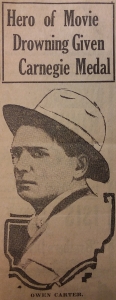
It wasn’t supposed to be a dramatic scene. For a movie depicting gun smuggling at the U.S. border with Mexico, this sequence simply was to show a bandit’s daughter crossing the Rio Grande on horseback.
On a bank of a shallow section of the Arkansas River in Cañon City, Colo., which was subbing for the Rio Grande, Owen Carter manned a camera for “Across the Border,” an ambitious production of the Colorado Motion Picture Co. Wearing a cowgirl’s outfit and boots, Grace Forman – known professionally as Grace McHugh – rode into the river that shortly would take her life. Carter lost his own trying to save hers.
Rumors of a publicity ruse initially marred some of the early details about Carter’s heroic rescue attempt on July 1, 1914, perhaps because several days passed before anyone located their bodies, apart, far downstream. Crew members themselves later explained they couldn’t quite comprehend how both Forman, 24, and Carter, 29, struggled in water that appeared to be no deeper than their waists, but they marveled at Carter’s effort.
In particular, director Otis B. Thayer insisted that Carter swam out to help McHugh “of his own free will and without any suggestion from myself or anyone else.”
“I am free to say that I never saw greater heroism displayed by anyone than was displayed by Mr. Carter in this instance,” Thayer wrote to the Hero Fund one month after the incident. “He was taking his life in his hands in attempting to go across the swift current of the river, and it certainly looked to me when I saw him last that he would succeed in making the rescue, but unfortunately he lost his life in his effort.”
The deaths were a stunning turn, especially given that the scene was being re-filmed because the previous version was damaged in the development process, according to author Michael J. Spencer’s book Hollywood of the Rockies: Colorado, The West and America’s Film Pioneers. “Across the Border” was the first film for Forman, who was 5 feet, 3 inches tall and weighed about 115 pounds.
Per accounts witnesses later provided to the Hero Fund, Forman rode into the river at a point where it was about 125 feet wide and about 3.5 feet deep. She was about 30 feet out when the horse stumbled and she fell into the water. An actor on horseback rode into the river to her and she grasped his hand, but they separated and she drifted downstream.
Carter, who previously worked as a harness maker, was considered a good swimmer and was about 8 inches taller and 50 pounds heavier than Forman. He entered the river and swam about 320 feet to Forman. Soon, they disappeared and drowned. Carter’s body was found five days later, more than a mile from the scene, while Forman’s body was missing until 12 days later, 9 miles from the scene, according to movie company officials.



